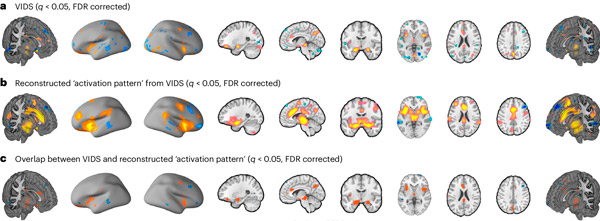
厌恶是人类六种基本情绪之一,其他五种情绪包括快乐、悲伤、恐惧、愤怒和惊讶。厌恶通常发生在一个人将感官刺激或情境视为令人厌恶、不愉快或其他令人作呕的事物时。
过去的心理学研究将厌恶定义为一种回避防御性情绪,并将其与某些面部表情、动作和生理反应联系起来。虽然厌恶主要与令人不快的食物味道、令人不快的气味或令人厌恶的图像有关,但它也可能由其他刺激引起,包括不愉快的社交互动。
中国电子科技大学等机构的研究人员最近开展了一项研究,旨在更好地理解厌恶的神经基础及其在食物摄入之外的普遍性。他们的研究结果发表在《自然人类行为》杂志上,表明主观厌恶的神经功能特征对于口腔厌恶和不愉快的社会道德体验是相同的。
“尽管厌恶源于哺乳动物根深蒂固的厌恶反应,但人类有意识的厌恶体验高度依赖于主观评价,甚至可以延伸到社会道德背景,”Xianyang Gang、Feng Zhou 及其同事在论文中写道。
“在一系列研究中,我们将功能性磁共振成像(fMRI)与基于机器学习的预测模型相结合,创建了一个全面的主观厌恶神经生物学模型。”

主观厌恶与大脑的分布区域相关,并由其预测。a,VIDS阈值图。b,VIDS阈值转换后的“激活”图。c,VIDS与转换后的“激活”图的叠加。图像阈值设为q < 0.05,并经过FDR校正。暖色表示正权重(a)或关联(b),冷色表示负权重(a)或关联(b)。来源:《自然-人类行为》(2024)。DOI:10.1038/s41562-024-01868-x
实验中,参与者被展示各种旨在唤起厌恶感的图片,并被要求对这些图片做出自然的反应。观看完每张图片后,参与者被要求以1(轻微/无厌恶)到5(强烈厌恶)的量表评估自己的厌恶程度。
通过使用功能磁共振成像(fMRI)监测参与者的大脑活动,并使用机器学习模型分析收集到的数据,研究人员能够描绘出与主观厌恶感知相关的神经特征。该特征准确地预测了参与者自我报告的厌恶程度,并很好地推广到基线厌恶、味觉厌恶以及对游戏中不公平提议的社会道德反应。
甘、周和同事在论文中写道:“厌恶体验被编码在分布式皮质和皮质下系统中,并在内感受情绪意识和意识评估系统中表现出与主观恐惧或负面影响独特且共同的神经表征,而特征最准确地预测了相应的目标体验。”
“我们提供了厌恶情绪的精确功能性磁共振成像特征,这对解决持续存在的进化争议具有很高的潜力。”
甘、周及其合著者最近的一项研究描述了与主观厌恶体验相关的大脑活动模式。具体而言,主观厌恶情绪同时在多个脑区编码,而非分散在多个脑区。
有趣的是,研究人员在人们体验厌恶的各种情境中观察到了相同的大脑神经信号,从品尝不愉快的食物,到同情他人的痛苦,再到收到不公平的待遇。这些发现可能很快会为进一步研究厌恶的神经功能特征的神经科学研究铺平道路,并可能带来令人兴奋的新发现。

